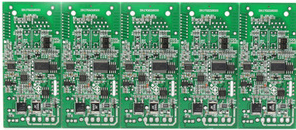Clamping diodes and transient voltage protection in PCB design are very important. Diodes, well known to many electronic product beginners, are semiconductors made of PN junctions. When a positive voltage is connected to the anode and the cathode is connected to the cathode, the diode is called forward biased. As long as the applied voltage is greater than the junction voltage (usually 0.7V), current will flow through the diode.
But what if the voltage is applied in the opposite direction? Under negative bias, as long as the voltage across the terminals does not exceed the breakdown voltage, the diode will be in a non-conducting state. In this state, the diode acts like an open circuit because the reverse-biased PN junction prevents electrons from flowing through.
Clamping diodes are where these two characteristics are used to manipulate the input voltage in the PCB circuit board design circuit. Clamping diodes can be used as level shifters and can also be used to protect components from transient voltages.
The diode in the clamp circuit
PCB positive clamping circuit.
The clamp circuit is composed of AC input, diode, capacitor and load resistance. The clamp circuit is divided into a positive configuration and a negative configuration. The figure above shows a positive clamp circuit, which is actually a positive level converter.
It works as follows:

In the first positive cycle, the diode is in a reverse biased state, and no current flows through the diode. Therefore, the first output peak is equal to the input.
When the input enters a negative cycle, the diode is placed in a forward biased state. It starts to conduct current and charges the capacitor to the magnitude of the peak voltage. When the input voltage approaches the positive cycle, the capacitor continues to hold the charge. In the negative cycle, the output voltage is 0V, or exactly 0.7V, which is the junction voltage of the diode.
In the next positive cycle, the diode is again placed in a reverse biased state. The diode is open. However, the capacitor was charged to the input voltage amplitude in the previous cycle. Now, the charge will be released through the load resistance, while a positive voltage peak is applied to the input. Both the input voltage and the charge stored in the capacitor will cause the measured amplitude to double at the output voltage.
But what about the PCB negative clamp circuit? By only reversing the direction of the diode, you will get an AC level shifter that works in reverse.
Transient protection of clamp diodes
Clamping diodes are not only related to baseline voltage drift. They can alleviate transient events, especially ESD and lightning surges. For example, when the input voltage rises above Vh, D1 is forward biased. Therefore, excessive current flows through D1 instead of the load. A current-limiting resistor is usually placed before the diode to ensure that the diode works within the limit.
The same applies when the input voltage drops below VL, and then D2 will be activated. By taking excess current away from the load and keeping the voltage below Vh, these diodes help prevent transient voltage damage to components.
Generally, choose a diode with greater current handling capability, low junction voltage and fast on-time for PCB ESD or surge protection. The current-limiting resistor must also be able to disable a large amount of heat when a large amount of current passes.